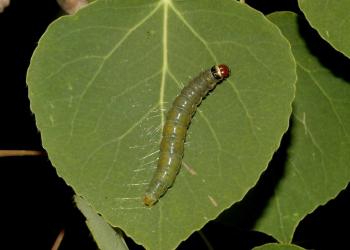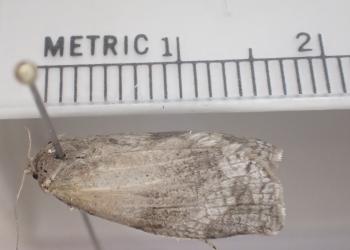Large Aspen Tortrix
Choristoneura conflictana (Walker)
Host(s) in Alaska: Quaking aspen (Populus tremuloides). Defoliation can occur to understory plants such as birch (Betula spp.) and spruce (Picea spp.) during outbreaks.
Habitat(s): Larvae reside in host leaves, while adults can be found in host stands.
General Distribution in Alaska: Southcentral and Interior Alaska.
Current Status in Alaska (2024)
No significant damage was recorded for large aspen tortrix in 2024.
Historic Activity
Due to the pandemic, aerial detection surveys were not conducted in 2020, which resulted in no aerially mapped damage for this agent. In 2019, while there was 365 acres of general aspen defoliation scattered throughout Interior and Western Alaska, including the Copper River Valley, no aerially mapped damage was directly attributed to the large aspen tortrix.
Prior to 2019, the more general aerial survey code “aspen defoliation” was used when it was not clear if damage was caused by large aspen tortrix or aspen running canker. Now that our ability to distinguish these agents from the air has improved, we use this survey code less. In 2019, the aspen defoliation aerial survey code was frequently used in areas with an atypical damage signature in aspen, warranting use of the more generic code.
Large aspen tortrix was mapped on <2,000 acres in 2018 near Tetlin Wildlife Refuge and along the Yukon River between the mouth of the Nowitna River and the town of Grayling. Aspen defoliation was mapped on roughly 18,000 acres during the 2018 aerial survey, with most damage in the Yukon Flats region (10,350 acres). Additional damage was scattered throughout Interior, Western, and Southcentral Alaska.
The first recorded large aspen tortrix outbreak in Alaska occurred from 1966-69, where thousands of acres of defoliation were recorded in the Interior, primarily in the Fairbanks area. Beginning in 1978, a large aspen tortrix outbreak was recorded near Willow, where tens of thousands of acres were defoliated over the next several years. The largest large aspen tortrix outbreak recorded in Alaska occurred from 1986-90 in the Fairbanks area with over 600,000 acres of aspen defoliated. Total defoliation of aspen occurred in many areas.
In Alaska, large aspen tortrix has a univoltine (one-year) life cycle and overwinter as small larvae (caterpillars) in bark crevices, at bases of trees, or along twigs. During the first two weeks of May, larvae become active and mine into unopened buds. Larval feeding can destroy leaves before buds open. As larvae mature, they turn gray-green to black in color with dark heads and feed more openly. In heavily defoliated aspen stands, understory plants, including spruce and birch, are eaten and often extensively "webbed." Mature caterpillars transform into black pupae and are generally found within rolled aspen leaves but can be on webbed understory plants. Adults emerge and are active from late June until early July. Large aspen tortrix moths are mostly gray with some brown markings on their forewings. They generally deposit green egg masses on upper leaf surfaces of host trees. Eggs hatch by end of July, and young caterpillars are active until mid-August. Within rolled leaves, young larvae feed on the lower and upper surfaces, leaving only a skeleton of the leaf. The new generation migrates to new, safe areas, and spins shelters within which to overwinter.
Large aspen tortrix periodically affects large areas of quaking aspen in Southcentral and Interior Alaska. When populations reach epidemic levels, outbreaks are generally short-lived, with populations tapering back to endemic population levels after 2 to 3 years. Under natural conditions, large aspen tortrix populations seem to cause little permanent damage. The most common effects of heavy large aspen tortrix feeding are a temporary reduction in tree growth and occasional branch and top dieback. Healthy hardwood trees can generally recover from several years of moderate to heavy feeding. Aspen trees can produce new leaves the same year after defoliation occurs, which is called reflushing. When trees are not healthy and vigorous when attacked, chances of mortality increase after two or more years of heavy infestation. This often occurs in areas of new building or road construction where trees are mechanically damaged and soils are compacted or excessive amounts of soil are placed on root systems.
Under natural conditions large aspen tortrix populations seem to cause little permanent damage. Artificially suppressing large numbers of large aspen tortrix on forested land is generally not warranted. They can, however, be more destructive in urban areas where human disturbances weaken aspen trees. Control alternatives in urban and suburban settings include a take-no-action approach, fertilization, and a chemical treatment.
1. Take-No-Action Approach
A healthy aspen tree can withstand a few years of large aspen tortrix feeding. Tree diameter and height will not be adversely affected; serious damage or death is uncommon. To assure good tree vigor, avoid damaging tree trunks, injuring roots, altering soil drainage patterns, or severely compacting soils.
2. Fertilization
Spring fertilization helps promote tree vigor. The UAF Alaska Cooperative Extension recommends approximately one pound of fertilizer per inch of tree diameter. Lawn or garden fertilizers high in phosphorus are adequate. Apply by making a series of holes, 8 to 10 inches deep, around trees starting two feet from trunks and extending a few feet beyond the dripline (The point where tree canopies shed water, forming a wet ring around plants following rain). Fertilizing should begin in spring and continue throughout the summer. Discontinue fertilization treatments prior to fall dormancy. Feeding programs may not be necessary every year. Fertilizer uptake, soil type, rainfall, weather, and grass cover will determine reapplication times.
3. Chemical Treatment
Chemical treatment may be warranted (see Pesticide Caution Statement below) if aspen trees show signs of extensive large aspen tortrix feeding for two consecutive years, and if top or branch dieback is apparent. If used, insecticides can be applied from mid-May until early June when aspen buds are open and new leaves are expanding. Young large aspen tortrix larvae are susceptible to chemical treatment at that time.
Presently, formulations of Bacillus thuringiensis (Bt), a bacteria which selectively targets Lepidoptera (moths and butterflies), are registered and can be used against large aspen tortrix. Several other insecticides for suppressing leafrollers, which are related to large aspen tortrix, have similar feeding habits, can be used. Always check with your local University of Alaska Cooperative Extension office for advice in selecting a chemical treatment.
Pesticide Caution Statement
Pesticides can be injurious to humans, domestic animals, desirable plants, and fish or other wildlife—if they are not handled or applied properly. Use all pesticides selectively and carefully. Since approved uses of a pesticide may change frequently, it is important to check labels for current approved and legal use. Follow recommended practices for disposal of surplus pesticides and pesticide containers. Mention of a pesticide on this website does not constitute a recommendation for use by the USDA, nor does it imply registration of a product under Federal Insecticide, Fungicide, and Rodenticide Act, as amended. Mention of a proprietary product does not constitute an endorsement by the USDA.
Distribution Map (2015-2018)
Damage from large aspen tortrix is mapped by aerial detection and ground surveys.

Links to Resources & Publications
Holsten, E. 1988. Large Aspen Tortrix. Alaska Region Forest Health Leaflet. Available here.
For more information, please contact Dr. Sydney Mullen, Entomologist, U.S. Forest Service, sydney.mullen@usda.gov.








